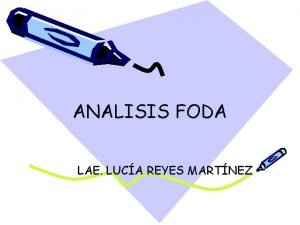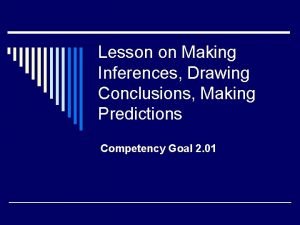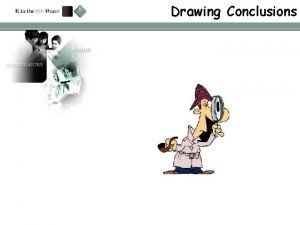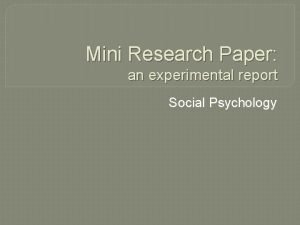conclusions a mini lesson for research conclusions the






- Slides: 6

conclusions a mini lesson for research

conclusions: the 3 Rs • Revisit thesis • Recap main arguments • Reflect/relate to leave audience thinking about your message

Revisit—not restate—your thesis Take your thesis and “revisit” it—not restate it. • Take your most essential argument and re-write it. For example, for Ima's paper, her thesis was: Although the current trend of education promotes standards-based learning, teachers must not forget the importance of imagination in the classroom. • • Identify key ideas from your thesis & say them in a new way. Circle the most important words/phrases that you want to include in your revisit to stay focused. Ima chose: "not forget"-remember to re-imagine; emphasize "importance of imagination"--role of imagination is dwindling "in the classrooms"--schools Ima's "revisit" The role of imagination in American education is dwindling and educators need to remember to “re”imagine their schools to emphasize it again.

Recap—not restate—your main arguments Take your main subtopic ideas & reflect on how those ideas build on one another/work together overall. Copy your Conclusion Sentences Verbatim from Each Body Paragraph Summarize the Important Arguments—Don’t just repeat your arguments but look at what’s important in each paragraph that you want to review. While the argument for standards seems like the answer, with them come significant drawbacks. Educators must not overlook the importance of imagination in the classroom. By focusing on balancing imagination and standards, educators will prepare students for success in and out of the classroom. Teachers must start considering these components so they may take back control of their classrooms Solving global problems requires innovative--an important way to produce the future innovators is to foster imagination in the classroom. In the face of an ever-standardizing world where students are compartmentalized, educators must learn to find equilibrium between state tests and the real, creative work in the classroom. Although teachers cannot change the policies aligned with No Child Left Behind itself, they can still reevaluate their practices and change the way they structure instruction, classrooms, and thinking about thinking. By doing so, they will ensure that the students, the future of the United States, will be able to engage in the creative, "outside-of-the-box" thinking they need to innovate in the changing 21 st century world of work and of living as they confront the questions and problems and possibilities that the future will bring.

Reflect/Relate—leave the reader thinking Take your argument and consider its implications, its importance in the bigger picture • how you choose to reflect/relate depends on what you're arguing. . . for example: o suggest an action o comment on how the argument is important in the "grand scheme" of the country/globe/humanity etc. By doing so, they will ensure that the students, the future of the United States, will be able to engage in the creative, "outside-of-the -box" thinking they need to innovate in the changing 21 st century world of work and of living as they confront the questions and problems and possibilities that the future will bring. • circle back/revisit your hook to bring closure Heeding the words of Robert Frost-“Two roads diverged in a wood, and I— I took the one less traveled by, And that has made all the difference. ” --it is time to make a difference and use imagination to do so.

ima's conclusion The role of imagination in American education is dwindling and educators need to “re”-imagine their schools to emphasize it again. In the face of an ever-standardizing world where students are compartmentalized, educators must learn to find equilibrium between state tests and the real, creative work in the classroom. Although teachers cannot change the policies aligned with No Child Left Behind itself, they can still reevaluate their practices and change the way they structure instruction, classrooms, and thinking about thinking. By doing so, they will ensure that the students, the future of the United States, will be able to engage in the creative, "outside-of-the-box" thinking they need to innovate in the changing 21 st century world of work and of living as they confront the questions and problems and possibilities that the future will bring. Heeding the words of Robert Frost-“Two roads diverged in a wood, and I— I took the one less traveled by, And that has made all the difference. ” --it is time to make a difference and use imagination to do so.










